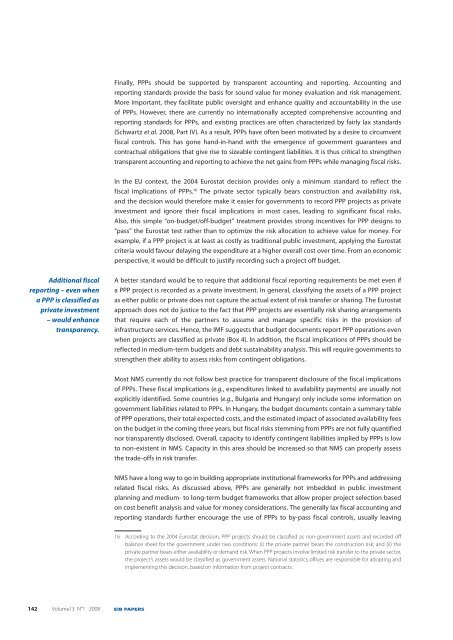EIB Papers Volume 13. n°1/2008 - European Investment Bank
EIB Papers Volume 13. n°1/2008 - European Investment Bank
EIB Papers Volume 13. n°1/2008 - European Investment Bank
Create successful ePaper yourself
Turn your PDF publications into a flip-book with our unique Google optimized e-Paper software.
Additional fiscal<br />
reporting – even when<br />
a PPP is classified as<br />
private investment<br />
– would enhance<br />
transparency.<br />
142 <strong>Volume</strong>13 N°1 <strong>2008</strong> <strong>EIB</strong> PAPERS<br />
Finally, PPPs should be supported by transparent accounting and reporting. Accounting and<br />
reporting standards provide the basis for sound value for money evaluation and risk management.<br />
More important, they facilitate public oversight and enhance quality and accountability in the use<br />
of PPPs. However, there are currently no internationally accepted comprehensive accounting and<br />
reporting standards for PPPs, and existing practices are often characterized by fairly lax standards<br />
(Schwartz et al. <strong>2008</strong>, Part IV). As a result, PPPs have often been motivated by a desire to circumvent<br />
fiscal controls. This has gone hand-in-hand with the emergence of government guarantees and<br />
contractual obligations that give rise to sizeable contingent liabilities. It is thus critical to strengthen<br />
transparent accounting and reporting to achieve the net gains from PPPs while managing fiscal risks.<br />
In the EU context, the 2004 Eurostat decision provides only a minimum standard to reflect the<br />
fiscal implications of PPPs. 16 The private sector typically bears construction and availability risk,<br />
and the decision would therefore make it easier for governments to record PPP projects as private<br />
investment and ignore their fiscal implications in most cases, leading to significant fiscal risks.<br />
Also, this simple “on-budget/off-budget” treatment provides strong incentives for PPP designs to<br />
“pass” the Eurostat test rather than to optimize the risk allocation to achieve value for money. For<br />
example, if a PPP project is at least as costly as traditional public investment, applying the Eurostat<br />
criteria would favour delaying the expenditure at a higher overall cost over time. From an economic<br />
perspective, it would be difficult to justify recording such a project off budget.<br />
A better standard would be to require that additional fiscal reporting requirements be met even if<br />
a PPP project is recorded as a private investment. In general, classifying the assets of a PPP project<br />
as either public or private does not capture the actual extent of risk transfer or sharing. The Eurostat<br />
approach does not do justice to the fact that PPP projects are essentially risk sharing arrangements<br />
that require each of the partners to assume and manage specific risks in the provision of<br />
infrastructure services. Hence, the IMF suggests that budget documents report PPP operations even<br />
when projects are classified as private (Box 4). In addition, the fiscal implications of PPPs should be<br />
reflected in medium-term budgets and debt sustainability analysis. This will require governments to<br />
strengthen their ability to assess risks from contingent obligations.<br />
Most NMS currently do not follow best practice for transparent disclosure of the fiscal implications<br />
of PPPs. These fiscal implications (e.g., expenditures linked to availability payments) are usually not<br />
explicitly identified. Some countries (e.g., Bulgaria and Hungary) only include some information on<br />
government liabilities related to PPPs. In Hungary, the budget documents contain a summary table<br />
of PPP operations, their total expected costs, and the estimated impact of associated availability fees<br />
on the budget in the coming three years, but fiscal risks stemming from PPPs are not fully quantified<br />
nor transparently disclosed. Overall, capacity to identify contingent liabilities implied by PPPs is low<br />
to non-existent in NMS. Capacity in this area should be increased so that NMS can properly assess<br />
the trade-offs in risk transfer.<br />
NMS have a long way to go in building appropriate institutional frameworks for PPPs and addressing<br />
related fiscal risks. As discussed above, PPPs are generally not imbedded in public investment<br />
planning and medium- to long-term budget frameworks that allow proper project selection based<br />
on cost benefit analysis and value for money considerations. The generally lax fiscal accounting and<br />
reporting standards further encourage the use of PPPs to by-pass fiscal controls, usually leaving<br />
16 According to the 2004 Eurostat decision, PPP projects should be classified as non-government assets and recorded off<br />
balance sheet for the government under two conditions: (i) the private partner bears the construction risk; and (ii) the<br />
private partner bears either availability or demand risk. When PPP projects involve limited risk transfer to the private sector,<br />
the project’s assets would be classified as government assets. National statistics offices are responsible for adopting and<br />
implementing this decision, based on information from project contracts.

















